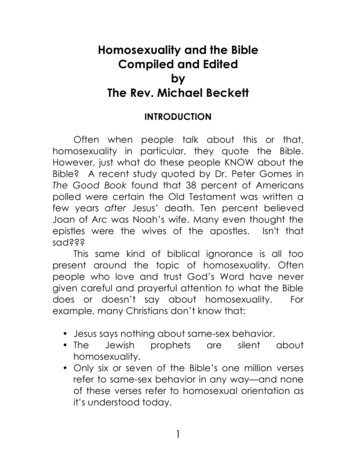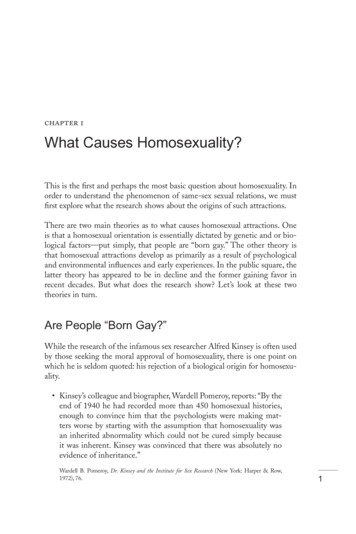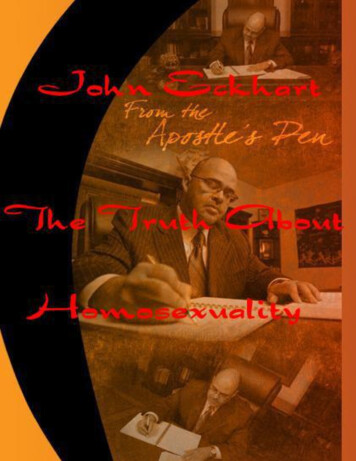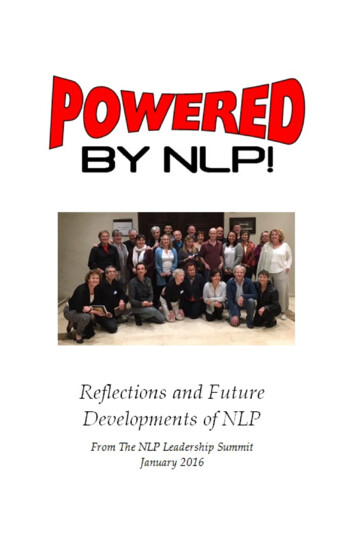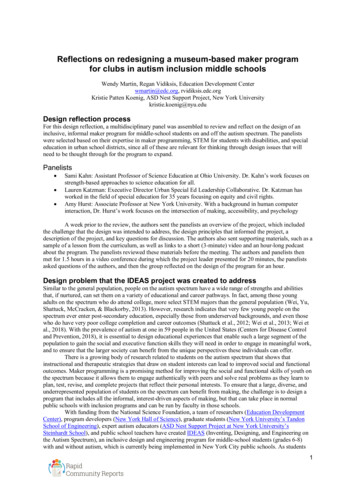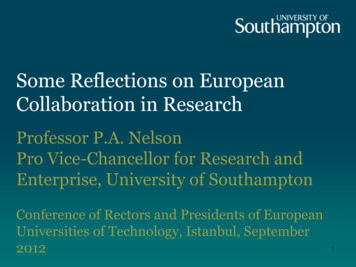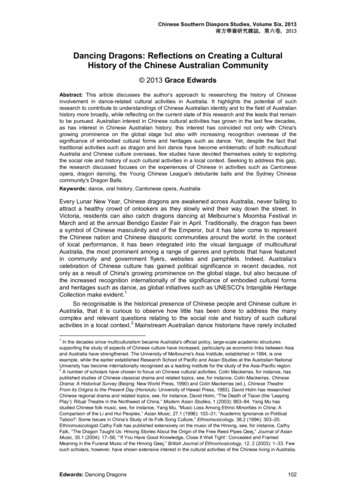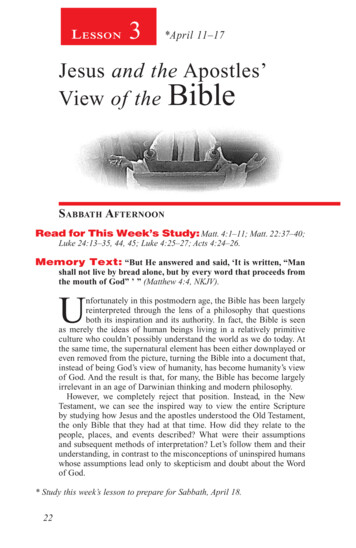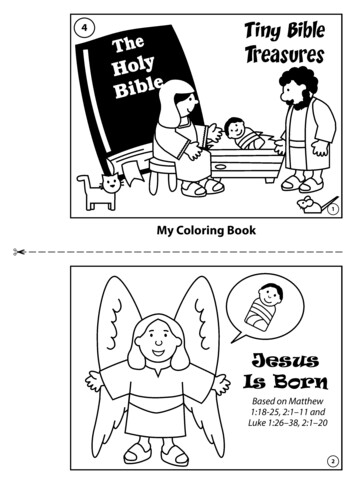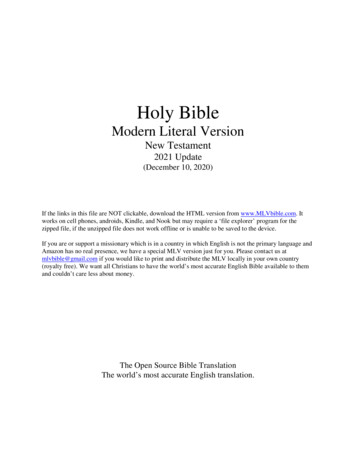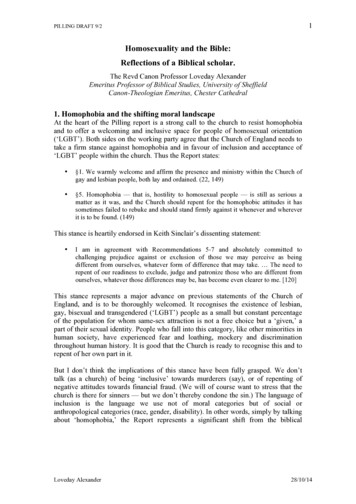
Transcription
1PILLING DRAFT 9/2Homosexuality and the Bible:Reflections of a Biblical scholar.The Revd Canon Professor Loveday AlexanderEmeritus Professor of Biblical Studies, University of SheffieldCanon-Theologian Emeritus, Chester Cathedral1. Homophobia and the shifting moral landscapeAt the heart of the Pilling report is a strong call to the church to resist homophobiaand to offer a welcoming and inclusive space for people of homosexual orientation(‘LGBT’). Both sides on the working party agree that the Church of England needs totake a firm stance against homophobia and in favour of inclusion and acceptance of‘LGBT’ people within the church. Thus the Report states: §1. We warmly welcome and affirm the presence and ministry within the Church ofgay and lesbian people, both lay and ordained. (22, 149) §5. Homophobia — that is, hostility to homosexual people — is still as serious amatter as it was, and the Church should repent for the homophobic attitudes it hassometimes failed to rebuke and should stand firmly against it whenever and whereverit is to be found. (149)This stance is heartily endorsed in Keith Sinclair’s dissenting statement: I am in agreement with Recommendations 5-7 and absolutely committed tochallenging prejudice against or exclusion of those we may perceive as beingdifferent from ourselves, whatever form of difference that may take. The need torepent of our readiness to exclude, judge and patronize those who are different fromourselves, whatever those differences may be, has become even clearer to me. [120]This stance represents a major advance on previous statements of the Church ofEngland, and is to be thoroughly welcomed. It recognises the existence of lesbian,gay, bisexual and transgendered (‘LGBT’) people as a small but constant percentageof the population for whom same-sex attraction is not a free choice but a ‘given,’ apart of their sexual identity. People who fall into this category, like other minorities inhuman society, have experienced fear and loathing, mockery and discriminationthroughout human history. It is good that the Church is ready to recognise this and torepent of her own part in it.But I don’t think the implications of this stance have been fully grasped. We don’ttalk (as a church) of being ‘inclusive’ towards murderers (say), or of repenting ofnegative attitudes towards financial fraud. (We will of course want to stress that thechurch is there for sinners — but we don’t thereby condone the sin.) The language ofinclusion is the language we use not of moral categories but of social oranthropological categories (race, gender, disability). In other words, simply by talkingabout ‘homophobia,’ the Report represents a significant shift from the biblicalLoveday Alexander28/10/14
2PILLING DRAFT 9/2viewpoint which sees homosexual practice as ‘sin’ and has no concept of homosexualidentity or ‘orientation’ (a concept which did not emerge until the 19th century).1This report thus represents — for both sides — a significant shift in what we mightcall the anthropology of desire: that is, the way we understand sexual preference anddesire as part of our sexual identity. This shift is based not on the Bible but on reason— that is, on a social perception widely shared across western European culture. Thejury is out (as Pilling recognises) on just how far our sexual identity depends ongenetic or on environmental factors, or on a mixture of the two. But the underlyingperception that our sexual identity is not about moral choice but about ‘orientation’ isnow the consensus position in western European society, and especially among theyounger generation who don’t even remember how recently homosexual activity wasdecriminalised in this country.I don’t think we should underestimate the huge (and surprisingly rapid) cultural shiftthat is involved here. But I am convinced that this is not simply a cultural fad but agenuine shift in moral perception, based not only on the solid evidence of psychiatryand medical science, but on the day-to-day experience of countless gay youngstersand their heterosexual parents and grandparents. It is a shift as momentous in its wayas the shift in the 19th-century perception of the ethics of slavery (though that was ashift in the opposite direction, from social category to moral issue) — and as troublingin its challenge to centuries of biblical interpretation.But if the moral landscape has shifted, where does that leave the Bible? If the worldof the Bible and the world we live in have moved apart, like tectonic plates, wheredoes that leave the Christian believer, with a foot on both sides, trying to straddle thecognitive gap? That, in essence, is the question at the heart of the debates that wehave been wrestling with over the past decade. These debates raise acutely thequestion of the relationship between an authoritative religious text from the past – theBible – and a society whose understanding of sexuality and gender roles is rapidlychanging, along with its understanding of human psychology and physiology – all ofwhich has to be factored into the ethical debate.For some people, it’s our culture that is wrong, not the Bible: the church needs toaffirm biblical teaching and stand out against the prevailing culture. For many others(both inside and outside the church), the Bible’s negative statements about womenand gays belong with those ‘texts of terror’ which have been used over the centuries‘to authorize appalling abuse, even murder, of women, Jews, slaves, colonizedpeoples, homosexuals’ – texts which come from ‘a culture whose ethicalpresuppositions and dispositions were inferior to the best of our own, a culture thatwas xenophobic, patriarchal, classist, and bloodthirsty.’2 The pace of criticism seemsif anything to have accelerated during the debate over gay marriage over the pastcouple of years, with many young people (under 40, that is) simply walking away1On the emergence and definition of the concept, see Marti Nissinen, Homoeroticism in the BiblicalWorld: A Historical Perspective (Minneapolis: Fortress Press, 1988), pp.5-10.2Ellen F.Davies and Richard B. Hays (ed.), The Art of Reading Scripture (Grand Rapids: Eerdmans,2003), p.165.Loveday Alexander28/10/14
3PILLING DRAFT 9/2from a church which they regard as ‘evil’ and a Bible that belongs to a world theydon’t recognise, which speaks with the voices of prejudice and oppression.3But ‘walking away’ from the Bible simply isn’t an option for me, or for the Church.We can’t just abandon this text which has nourished the life of faith for two millennia.I can’t turn my back on a text which has sustained and informed my own faith for aslong as I can remember. We have to stay with the Bible — but we have to find a wayof making sense of it, in a world that is very different from the world (or ratherworlds) in which it was written. This is one of the key theological tasks facing us inthe church today; and in this paper I want to share with you some of the principles andstrategies I would adopt, as a biblical scholar, to tackle it. I should stress that this isvery much my own personal approach: but I hope it may help to open up some of themoves we might make to resolve the dilemmas we face in seeking to make sense ofthe Bible in today’s church — and today’s world. 42. Scripture, tradition and reason.So the first set of questions raised by this report are questions about hermeneuticalmethod: and more particularly, in an Anglican context, a question about therelationship between scripture, tradition, and reason. This is a case where reasonseems to lead in a direction that is (on the face of it) at odds with the united witness ofscripture and tradition. This is not of course a new problem: it is one the church hashad to face over the gender issues, and one that most believers have to face (thoughthe church has not attempted a public statement on this) over scientific issues such asevolution and creation.But we need to note that both sides represented in the Pilling report face the sameproblem here. It is a problem that is faced by any faith, culture or discipline whichinvests authority in a canonic text: that is, the need to ‘find an interpretation thatharmonizes with the facts’. The text says one thing, the facts (science, perception,experience) say another: the task of theological interpretation (as opposed to historicalinterpretation, which doesn’t have this problem) is to bridge the credibility gap. If wecan’t, then something has to give: either reason, or the authority of the text. And it is ameasure of the seriousness with which we invest the authority of the text that wewould even attempt to find a way of ‘making sense’ of both. The task of creativehermeneutics is only for those who take Scripture seriously.5We often speak as if Scripture, tradition and reason are autonomous and isolatedstreams of revelation: but in fact they are inextricably intertwined. Already inscripture (as F.F.Bruce pointed out years ago) ‘we can recognise the threefold cord:3This point is strikingly confirmed by the research by Linda Woodhead and Rob Warner quoted in the‘Church Health Check’ section of the Church Times on 31st January 2014. Woodhead (p.24) notes a‘striking disconnect between wider social values and the Church’s official teaching.’ ‘There has been avalues revolution since the 1980s in Britain over the status and treatment of women, gay people, andchildren,’ with the result that young people today ‘now state a strong moral objection [to the church]’and see the church as prejudiced because “it discriminates against women and gay people”.’ Warner(p.25) notes that the Church is increasingly coming under judgment from the ‘new moral consensus,’which has ‘shifted irrevocably — not just among non-Christians but among Christians, too.’4Loveday Alexander, ‘God’s Frozen Word: Canonicity and the Dilemmas of Biblical Studies Today,’Expository Times 117/6 (2006), pp.237-42.5See the excellent series of studies in Richard Bauckham and Benjamin Drewery (ed.). Scripture,Tradition and Reason: A Study in the Criteria of Christian Doctrine (Edinburgh: T & T Clark, 1988).Loveday Alexander28/10/14
4PILLING DRAFT 9/2Scripture; interpretative tradition (incipient, but already necessary); reason (apartfrom which neither text nor interpretation could have been understood).’6 Thescriptural writers themselves are embedded in the rational processes of their ownculture, as are the continuous processes of translation and interpretation that preservethe scriptures in the life of the church.7‘Reason’ in this debate stands not simply for an abstract process of logicaldeduction: we could also describe it as a way of paying attention to the world.8 Andit is a purely arbitrary assumption that everything that happens in the world isautomatically contrary to the will of God. Not all moral shifts are godless: some ofthem (slavery is a case in point) may actually owe something to the effects ofcenturies of Christian thinking within society. Listening to the voice of reason andexperience is consistent with the prophetic hermeneutic to which Scripture itselfbears witness, a hermeneutic that starts by paying attention to what God is doing inthe world before trying to make sense of it within a scriptural framework. And this isa hermeneutic deeply embedded within Scripture itself.‘Tradition’ too should not be conceived in a static fashion. As Richard Bauckhampoints out, ‘The Christian tradition is by no means inevitably traditionalist. Itseschatological hope and its missionary orientation press it towards constantlychanging contextualizations of the Gospel, in which the resources of the past arebrought into critical relationship with the present context with a view to the future.’9This is a hermeneutic that treats the Bible not as a text frozen in time but as the wordof the Living God; and this process of ‘contemporization’ is already evident inscripture itself.10 We can illustrate it from a passage from Acts (chs 10-15), whichshows the church wrestling with a paradigm shift every bit as traumatic as thedebates over gender and sexuality we wrestle with today. For Peter and the apostles,the admission of Gentiles to the church challenged inherited taboos and traditionalreadings of Scripture just as acutely as those debates challenge ours.11 In Acts ch.10, Peter is led out by the Spirit, step by painful step, into the realisationthat ‘God is no respecter of persons’ (10.34). God isn’t only at work inside the faithcommunity, God is at work in the world, among people who look like ‘outsiders,’people classed as ‘unclean,’ people whom God inspires to reach out and ask for ashare in the saving Word about Jesus of Nazareth. And when Peter (cautiously andhesitantly) offers to share that Word with them, to share his testimony, it is God6F.F.Bruce, ‘Scripture in relation to Tradition and Reason,’ in Bauckham & Drewery, Scripture,Tradition and Reason, pp.35-64.7See for example Frances Young, Biblical Exegesis and the Formation of Christian Culture(Cambridge: Cambridge University Press, 1997).8It is an ‘error to think that the only law which God hath appointed unto men is the sacredscripture:’ Hooker I xiv.4, cited by Henry Chadwick in Bauckham and Drewery, Scripture, Traditionand Reason, p.294.9Bauckham and Drewery, Scripture, Tradition and Reason, p.137.10Cf. Ellen F. Davis, ‘Critical Traditioning: Seeking an Inner Biblical Hermeneutic,’ in Davis andHays, The Art of Reading Scripture, pp.163-80.11For a fuller exegesis, see Loveday Alexander, ‘”This is That”: The Authority of Scripture in the Actsof the Apostles,’ in Aaron Son (ed.), History and Exegesis: New Testament Essays in Honor of Dr. E.Earle Ellis for His 80th Birthday (London: T & T Clark International, 2006), pp.55-72; Luke TimothyJohnson, Scripture and Discernment: Decision Making in the Church (Nashville: Abingdon Press,1996).Loveday Alexander28/10/14
5PILLING DRAFT 9/2who showers them with the blessing of the Spirit, before baptism o
England, and is to be thoroughly welcomed. It recognises the existence of lesbian, gay, bisexual and transgendered (‘LGBT’) people as a small but constant percentage of the population for whom same-sex attraction is not a free choice but a ‘given,’ a part of their sexual identity. People who fall into this category, like other minorities in
